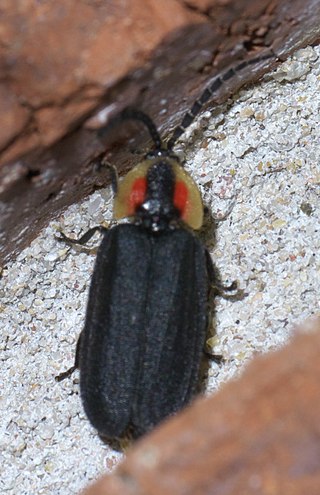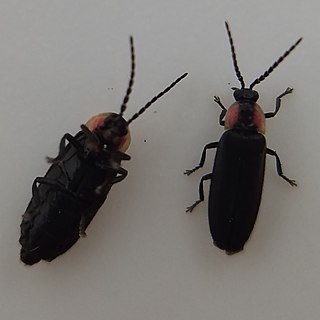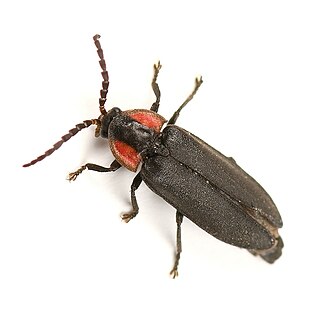
The Lampyridae are a family of elateroid beetles with more than 2,000 described species, many of which are light-emitting. They are soft-bodied beetles commonly called fireflies, lightning bugs, or glowworms for their conspicuous production of light, mainly during twilight, to attract mates. Light production in the Lampyridae is thought to have originated as an honest warning signal that the larvae were distasteful; this was co-opted in evolution as a mating signal in the adults. In a further development, female fireflies of the genus Photuris mimic the flash pattern of Photinus species to trap their males as prey.
Glowworm or glow-worm is the common name for various groups of insect larvae and adult larviform females that glow through bioluminescence. They include the European common glow-worm and other members of the Lampyridae, but bioluminescence also occurs in the families Elateridae, Phengodidae and Rhagophthalmidae among beetles; as well as members of the genera Arachnocampa, Keroplatus and Orfelia among keroplatid fungus gnats.

The rover fireflies (Photinus) are a genus of fireflies. They are the type genus of tribe Photinini in subfamily Lampyrinae. This genus contains, for example, the common eastern firefly, the most common species of firefly in North America.
Microphotus is a genus of fireflies in the family Lampyridae. Microphotus are usually found in the southwestern region of the United States of America and adjoining parts of Mexico. There are seven described species in Microphotus in the United States and three more in Mexico.
Pyropyga modesta is a species of firefly in the beetle family Lampyridae. It is found in Central America and North America.

Lucidota is a genus of fireflies in the beetle family Lampyridae. There are more than 160 described species in Lucidota.
Photinus concisus is a species of firefly in the beetle family Lampyridae. It is found in Kerrville, Texas. It the species most closely related to Photinus pyralis.
Microphotus angustus is a species of firefly in the beetle family Lampyridae. It is found in North America.
Prolutacea is a genus of fireflies in the family of beetles known as Lampyridae, containing a single described species, Prolutacea pulsator.
Nelsonphotus is a genus of fireflies in the family of beetles known as Lampyridae, containing a single described species, Nelsonphotus aridus.
Tenaspis is a genus of fireflies in the beetle family Lampyridae. There are about 18 described species in Tenaspis.

Pyropyga minuta is a species of firefly in the beetle family Lampyridae. It is found in Central America, North America, and South America.

Pyropyga nigricans is a species of firefly in the family of beetles known as Lampyridae. It is found in Central America, North America and central Europe.
Bicellonycha wickershamorum is a species of firefly in the beetle family Lampyridae. It is found in North America.
Bicellonycha is a genus of fireflies in the beetle family Lampyridae. There are more than 40 described species in Bicellonycha.
Pterotus is a genus of fireflies in the beetle family Lampyridae. There are at least two described species in Pterotus.
Pyropyga decipiens is a species of firefly in the beetle family Lampyridae. It is found in North America.
Paraphausis is a genus of fireflies in the family of beetles known as Lampyridae, containing a single described species, Paraphausis eximius.
Microphotus octarthrus, the desert firefly, is a species of firefly in the beetle family Lampyridae. It is found in North America.
Pollaclasis is a genus of fireflies in the beetle family Lampyridae. There is one described species in Pollaclasis, P. bifaria. Pollaclasis is most closely related to Pterotus, and may someday become included within the Pterotinae subfamily.





